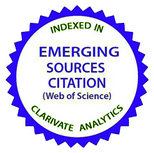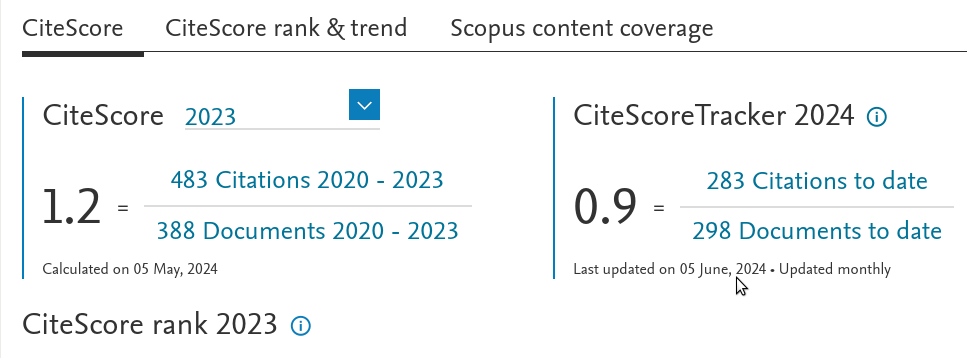Електронні властивості легованого вурциту ZnO в теорії функціонала щільності
DOI:
https://doi.org/10.15407/ujpe65.3.268Ключові слова:
zinc oxide, Hubbard U method, nitrogen doping, electronic properties, density functional theory, charge densityАнотація
Теорiю функцiонала щiльностi застосовано до розгляду електронних властивостей чистого i легованого азотом вурциту ZnO. Метод Хаббарда U (DFT + Ud + Up) використано для корекцiї недооцiнки величини забороненої зони. Результати ї ї розрахунку виявилися вiдповiдними наявним експериментальним даним. Розглянуто чотири рiзнi конфiгурацiї легованого азотом вурциту ZnO. Показано, що величина забороненої зони для ZnO залежить вiд концентрацiї азоту.
Посилання
U. Ozgur, Y.I. Alivov, C. Liu, A. Teke, M.A. Reshchikov, S. Dogan, V. Avrutin, S.J. Cho, H. Morkoc. A comprehensive review of ZnO materials and devices. J. Appl. Phys. 98, 041301 (2005). https://doi.org/10.1063/1.1992666
J.A. Talla. Ab initio simulations of doped single-walled carbon nanotube sensors. Chem. Phys. 392, 71 (2012). https://doi.org/10.1016/j.chemphys.2011.10.014
A. Janotti, C.G. Van de Walle. Fundamentals of zinc oxide as a semiconductor. Rep. Prog. Phys. 72, 126501 (2009). https://doi.org/10.1088/0034-4885/72/12/126501
M.M. Monshi, S.M. Aghaei, I. Calizo. Band gap opening and optical absorption enhancement in graphene using ZnO nanocluster. Phys. Lett. A 382, 1171 (2018). https://doi.org/10.1016/j.physleta.2018.03.001
P. Xu, Q. Tang, Z. Zhou. Structural and electronic properties of graphene-ZnO interfaces: dispersion-corrected density functional theory investigations. Nanotechnology 24, 305401 (2013). https://doi.org/10.1088/0957-4484/24/30/305401
F.S. Saoud, J.C. Plenet, M. Henini. Band gap and partial density of states for ZnO: Under high pressure. J. Alloys and Compounds 619, 812 (2016). https://doi.org/10.1016/j.jallcom.2014.08.069
Y.-S. Kim, W.-P. Tai. Electrical and optical properties of Al-doped ZnO thin films by sol-gel process. Appl. Surface Sci. 253, 4911 (2007). https://doi.org/10.1016/j.apsusc.2006.10.068
R. Rusdi, A.A. Rahman, N.S. Mohamed, N. Kamarudin, N. Kamarulzaman. Preparation and band gap energies of ZnO nanotubes, nanorods and spherical nanostructures. Powder Techn. 210, 18 (2011). https://doi.org/10.1016/j.powtec.2011.02.005
J. Zhao, L. Qin, L. Zhang. Synthesis of quasi-aligned Si-doped ZnO nanorods on Si substrate. Physica E: Low-dimens. Syst. Nanostruct. 40, 795 (2008). https://doi.org/10.1016/j.physe.2007.10.057
A.A. Peyghan, M. Noei. The alkali and alkaline earth metal doped ZnO nanotubes: DFT studies. Physica B: Condensed Matter 432, 105 (2014). https://doi.org/10.1016/j.physb.2013.09.051
F. Marcillo, L. Villamagua, A. Stashans. Analysis of electrical and magnetic properties of zinc oxide: A quantum mechanical study. Int. J. Modern Phys. B 31, 1750111 (2017). https://doi.org/10.1142/S0217979217501119
Y. Zhang, Y.-H. Wen, J.-C. Zheng, Z.-Z. Zhu. Strain-induced structural and direct-to-indirect band gap transition in ZnO nanotubes. Phys. Lett. A 374, 2846 (2010). https://doi.org/10.1016/j.physleta.2010.04.069
H. Xu, R.Q. Zhang, X. Zhang, A.L. Rosa, T. Frauenheim. Structural and electronic properties of ZnO nanotubes from density functional calculations. Nanotechnology 18, 485713 (2007). https://doi.org/10.1088/0957-4484/18/48/485713
S.S. Parhizgar, J. Beheshtian. Effect of nitrogen doping on electronic and optical properties of ZnO sheet: DFT+U study. Comput. Condensed Matter 15, 1 (2018). https://doi.org/10.1016/j.cocom.2018.03.001
F. Maldonado, A. Stashans. Al-doped ZnO: Electronic, electrical and structural properties. J, Phys. Chem. Sol. 71, 784 (2010). https://doi.org/10.1016/j.jpcs.2010.02.001
J.A. Talla. Pressure induced phase transition and band gap controlling in defective graphene mono-sheet: Density functional theory. Mater. Res. Express 6, 115012 (2019). https://doi.org/10.1088/2053-1591/ab4408
J.A. Talla. Band gap tuning of defective silicon carbide nanotubes under external electric field: Density functional theory. Phys. Lett. A 383, 2076 (2019). https://doi.org/10.1016/j.physleta.2019.03.040
J.A. Talla, A.F. Alsalieby. Effect of uniaxial tensile strength on the electrical properties of doped carbon nanotubes: Density functional theory. Chinese J. Phys. 59, 418 (2019). https://doi.org/10.1016/j.cjph.2019.01.022
J.A. Talla, K.A. Al-Khaza'leh, A.A. Ghozlan. Boron nitride nanotubes as a container for 5-fluorouracil anticancer drug molecules: Molecular dynamics simulation study. Adv. Sci., Engineer. Medicine 11, 1 (2019). https://doi.org/10.1166/asem.2019.2357
A.A. Ghozlan, J.A. Talla. Optical properties of defective silicon carbide nanotubes: Theoretical study. Rev. Cubana Fis. 36, 27 (2019).
E. Almahmoud, J.A. Talla. Band gap tuning in carbon doped boron nitride mono sheet with Stone-Wales defect: a simulation study. Mater. Res. Express 6, 105038 (2019). https://doi.org/10.1088/2053-1591/ab39a3
E.A. Almahmoud, J.A. Talla, H. Abu-Farsakh. Influence of uniaxial strain on the electronic properties of doped graphene mono-sheets: A theoretical study. Mater. Res. Express 6, 115617 (2019). https://doi.org/10.1088/2053-1591/ab4e28
J.A. Talla. Band-gap modulation of carbon nanotubes with Haeckelite structure under a transverse electric field: A first principle study. Comput. Condensed Matter 15, 25 (2018). https://doi.org/10.1016/j.cocom.2018.03.005
J.A. Talla, M. Nairat, K. Khazaeleh, A.A. Ghozlan, S.A. Salman. Optical properties of carbon nanotubes with Haeckelite structure under a transverse electric field: Density functional theory. Comput. Condensed Matter 16, e00311 (2018). https://doi.org/10.1016/j.cocom.2018.e00311
J.A. Talla, A.A. Ghozlan. Effect of boron and nitrogen codoping on CNT's electrical properties: Density functional theory. Chinese J. Phys. 56, 740 (2018). https://doi.org/10.1016/j.cjph.2018.01.009
Y. Zhao, J. Gong, H. Yang, P. Yang. Impact of high pressure on the optical and electrical properties of indium-doped n-type wurtzite zinc oxide according to first principles. Mater. Sci. Semicond. Proces. 19, 66 (2014). https://doi.org/10.1016/j.mssp.2013.10.030
M.F. Khana, K. Siraj, A. Sattarb, A.U.H. Faiz, J. Raisanen. Modification of structural and electrical properties of ZnO thin films by Ni2+ ions irradiation. Digest J. Nanomater. Biostructures 12, 689 (2017).
H.-C. Wu, Y.-C. Peng, T.-P. Shen. Electronic and optical properties of substitutional and interstitial Si-doped ZnO. Materials 5, (2012). https://doi.org/10.3390/ma5112088
R.M. Sheetz, I. Ponomareva, E. Richter, A.N. Andriotis, M. Menon, Defect-induced optical absorption in the visible range in ZnO nanowires. Phys. Rev. B 80, 195314 (2009). https://doi.org/10.1103/PhysRevB.80.195314
Downloads
Опубліковано
Як цитувати
Номер
Розділ
Ліцензія
Ліцензійний Договір
на використання Твору
м. Київ, Україна
Відповідальний автор та співавтори (надалі іменовані як Автор(и)) статті, яку він (вони) подають до Українського фізичного журналу, (надалі іменована як Твір) з одного боку та Інститут теоретичної фізики імені М.М. Боголюбова НАН України в особі директора (надалі – Видавець) з іншого боку уклали даний Договір про таке:
1. Предмет договору.
Автор(и) надає(ють) Видавцю безоплатно невиключні права на використання Твору (наукового, технічного або іншого характеру) на умовах, визначених цим Договором.
2. Способи використання Твору.
2.1. Автор(и) надає(ють) Видавцю право на використання Твору таким чином:
2.1.1. Використовувати Твір шляхом його видання в Українському фізичному журналі (далі – Видання) мовою оригіналу та в перекладі на англійську (погоджений Автором(ами) і Видавцем примірник Твору, прийнятого до друку, є невід’ємною частиною Ліцензійного договору).
2.1.2. Переробляти, адаптувати або іншим чином змінювати Твір за погодженням з Автором(ами).
2.1.3. Перекладати Твір у випадку, коли Твір викладений іншою мовою, ніж мова, якою передбачена публікація у Виданні.
2.2. Якщо Автор(и) виявить(лять) бажання використовувати Твір в інший спосіб, як то публікувати перекладену версію Твору (окрім випадку, зазначеного в п. 2.1.3 цього Договору); розміщувати повністю або частково в мережі Інтернет; публікувати Твір в інших, у тому числі іноземних, виданнях; включати Твір як складову частину інших збірників, антологій, енциклопедій тощо, то Автор(и) мають отримати на це письмовий дозвіл від Видавця.
3. Територія використання.
Автор(и) надає(ють) Видавцю право на використання Твору способами, зазначеними у п.п. 2.1.1–2.1.3 цього Договору, на території України, а також право на розповсюдження Твору як невід’ємної складової частини Видання на території України та інших країн шляхом передплати, продажу та безоплатної передачі третій стороні.
4. Строк, на який надаються права.
4.1. Договір є чинним з дати підписання та діє протягом усього часу функціонування Видання.
5. Застереження.
5.1. Автор(и) заявляє(ють), що:
– він/вона є автором (співавтором) Твору;
– авторські права на даний Твір не передані іншій стороні;
– даний Твір не був раніше опублікований і не буде опублікований у будь-якому іншому виданні до публікації його Видавцем (див. також п. 2.2);
– Автор(и) не порушив(ли) права інтелектуальної власності інших осіб. Якщо у Творі наведені матеріали інших осіб за виключенням випадків цитування в обсязі, виправданому науковим, інформаційним або критичним характером Твору, використання таких матеріалів здійснене Автором(ами) з дотриманням норм міжнародного законодавства і законодавства України.
6. Реквізити і підписи сторін.
Видавець: Інститут теоретичної фізики імені М.М. Боголюбова НАН України.
Адреса: м. Київ, вул. Метрологічна 14-б.
Автор: Електронний підпис від імені та за погодження всіх співавторів.

















